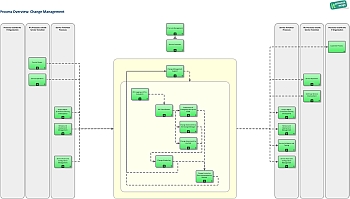Change Management
| diese Seite auf Deutsch |
|---|
ITIL Version: ITIL Version 3 (ITIL V3)
Process Objective: To control the lifecycle of all Changes. The primary objective of Change Management is to enable beneficial Changes to be made, with minimum disruption to IT services.
Part of: Service Transition
Process Owner: Change Manager
ITIL V3 vs. ITIL V2: Change Management
- Essentially, the activities and process objectives of the Change Management process are identical in ITIL V2 and V3
- ITIL V3 introduces "Change Models", putting more emphasis on defining different types of Changes and how they are to be handled
- Emergency Changes in ITIL V3 are authorized by the Emergency Change Advisory Board (ECAB), which was known as the Emergency Committee (EC) in ITIL V2
Sub-Processes of Change Management (ITIL V3)

- Change Management Support
- Process Objective: To provide templates and guidance for the authorization of Changes, and to supply the other IT Service Management processes with information on planned and ongoing Changes.
- RFC Logging and Pre-Evaluation
- Process Objective: To filter out Requests for Change which do not contain all information required for assessment or which are deemed impractical.
- RFC Classification
- Process Objective: To verify if the priority of the proposed Change was correctly set by the initiator, and to determine the adequate level of authority to approve or reject the RFC.
- Assessment of Urgent RFC by the ECAB
- Process Objective: To authorize, adjust or reject an urgent Request for Change as quickly as possible. This process is invoked if normal Change Management procudures cannot be applied because an emergency requires immediate action.
- Change Assessment by the Change Manager
- Process Objective: To authorize or reject a proposed Change as well as to ensure a preliminary scheduling and incorporation into the Change Schedule.
- Change Assessment by the CAB
- Process Objective: To authorize or reject a proposed Change as well as to ensure a preliminary scheduling and incorporation into the Change Schedule.
- Change Scheduling
- Process Objective: To agree a preliminary schedule for Change implementation and to transfer responsibility for Change deployment to Project and Release Management.
- Change Evaluation (Post Implementation Review)
- Process Objective: To assess the course of the Change implementation and the achieved results, in order to verify that a complete history if activities is present for future reference, and to make sure that any mistakes are analysed and lessons learned.
Related Key Performance Indicators






